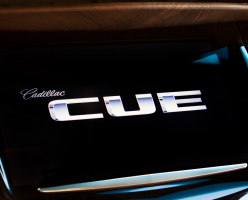
— A Cadillac CUE class action lawsuit has survived another dismissal challenge from General Motors, but only a few California claims remain from the four plaintiffs who sued.
The judge has allowed the plaintiffs to change and refile their lawsuit three times, but this time the judge dismissed certain claims without leave to amend the claims.
The Cadillac CUE class action lawsuit includes:
"Plaintiffs [who] seek to represent a Class of all persons and entities who purchased or leased 2013 to 2017 Cadillac ATS, SRX, and XTS vehicles and 2014 to 2017 Cadillac CTS, ELR, and Escalade vehicles equipped with General Motors’ Cadillac User Experience [CUE] touch screen display in the state of California."
According to the Cadillac CUE lawsuit, those models have defective infotainment touchscreens that delaminate or separate from the touchscreen glass.
The CUE infotainment system controls the audio, phone and climate inputs for the car and displays the backup camera image. But the plaintiffs allege mechanical or thermal stress causes the CUE touchscreen to show spiderweb-like patterns on the display.
This allegedly prevents a vehicle occupant from using the touchscreen due to the placement of the screws and rubberized gasket that hold the plastic cover to the frame of the CUE.
Specifically, the Cadillac CUE class action lawsuit alleges the plastic cover is anchored to the touch screen by eight screws, but only two screws are placed on “the bottom portion of the plastic cover, which causes it to flex and move when pressure is applied.”
The plaintiffs claim this makes the plastic cover prone to separating from the touchscreen glass.
Additionally, the rubber gasket is allegedly cut in a way that creates too much space between the touchscreen and the plastic cover, which “allows for more flexibility in the plastic cover, which leads to the spider-webbing defect.”
The CUE class action further alleges temperature changes cause delamination between the plastic cover and the touchscreen glass.
Bringing the Cadillac to a dealer allegedly does no good because any replacement CUE components are replaced with equally defective replacement parts.
Motion to Dismiss the Cadillac CUE Class Action Lawsuit
Because this was the third amended lawsuit filed by the plaintiffs, multiple claims against GM had already been dismissed in previous actions.
This time around Judge Linda Lopez dismissed several claims and granted GM's motion to dismiss "injunctive claims (1) to remove and replace their CUE Systems with a suitable alternative product that does not contain the alleged defects and (2) to perform a recall and repair."
The judge also dismissed a claim against GM to prevent the automaker from selling or leasing the Cadillac vehicles, and certain California and unjust enrichment claims were also dismissed.
The plaintiffs did find support for a claim they have standing to compel General Motors to "reform its warranty to cover the injury alleged and to notify all Class Members that such warranty has been reformed."
Judge Lopez also refused to dismiss the "implied warranty of merchantability claim pursuant to California Commercial Code section 2314."
The Cadillac CUE class action lawsuit was filed in the U.S. District Court for the Southern District of California - Goldstein, et al., v. General Motors LLC.
The plaintiffs are represented by Capstone Law, and Berger Montague.




